Claude Monet is one of the most popular "Impressionist" painters you see around.
In this issue, we will explain his unique style of painting production, focusing on his famous series of "Waterlilies" and other works.
Monet's masterpiece "Waterlilies" series
A series of approximately 250 paintings painted during his lifetime
Monet is famous for depicting the ever-changing light illuminating a landscape in his paintings.
Before Monet, classical paintings were created in dimly lit studios over long periods of time, based on sketches and preliminary drawings.
Impressionist painters such as Monet, Renoir, Sisley, and Pissarro, by contrast, went outside and directly copied what they saw in bright light. Although it took a long time to be accepted because it was innovative at the time, it is no exaggeration to say that nowadays, "Impressionism is even the name of art.
What is a series of paintings?
Monet often used the technique of "serialism.
A serial work is one in which the same motif is used repeatedly while capturing the effect of light that subtly changes with the seasons, weather, and time of day.
Monet created a series of paintings in the 1890s, including "Stacks of Straw," "Poplar Trees," and "Rouen Cathedral.
His masterpiece "Water Lilies," which became his life's work using the serial painting technique, was also painted repeatedly, using the garden he had set up on his own land in Giverny as a motif.
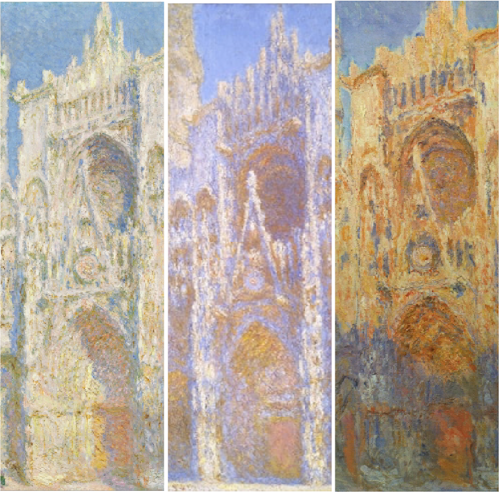
Rouen Cathedral
The first series of "Waterlilies
Monet's Waterlilies are divided into two series: the first from 1895 to 1900, and the second series from 1903 onward.
The first series is characterized by the motif of his garden in Giverny, where he built a Japanese-style bridge, and depicts a pond and weeping willows with changing light.
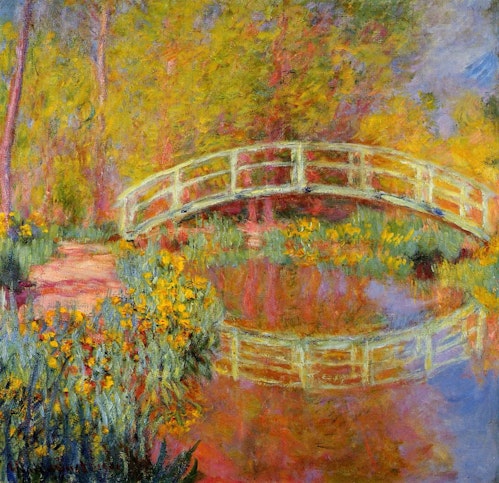
Bridge in Monet's Garden (w.1419a), 1895
.jpg?w=500&h=310)
Water Lilies" (w.1501) 1897 - 98
This is one of eight works painted between 1897 and 1899 with a relatively realistic touch.
The drum bridge painted earlier in 1895 is not depicted, and the composition is cropped.
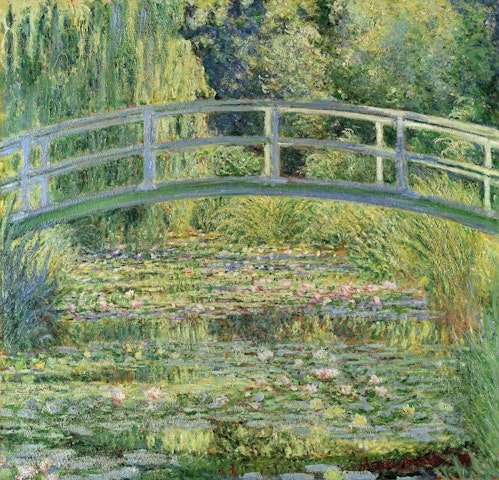
Water Lilies Pond (w.1516), 1899, Philadelphia Museum of Art
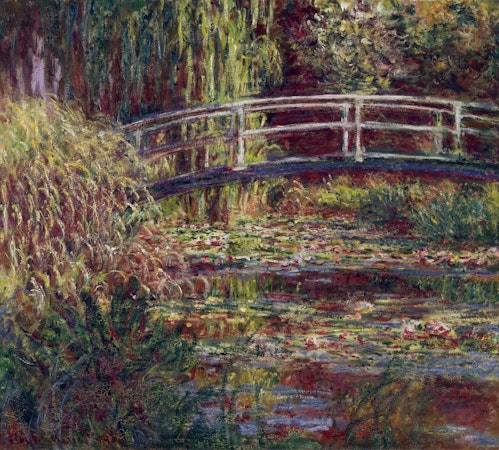
Water Lilies Pond, Rosy Harmony (w.1629), 1900, Musée d'Orsay
The Second Series of "Waterlilies
Production of "Waterlilies" was interrupted for a while, and was not resumed until 1903.
During this period, in 1901, Monet began work on the expansion of the pond. 80 paintings of "Waterlilies" produced between 1903 and 1908 have been identified.
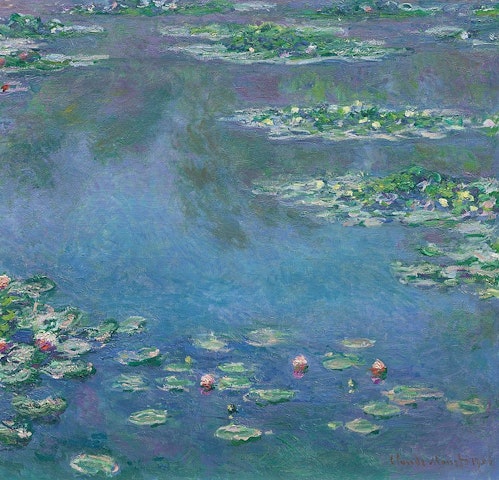
Water Lilies" (w.1683), 1906
From the second series of paintings, the screen is a complex mixture of the water surface and its reflection of imaginary trees and the sky, and the real image of the water lilies.
Sometimes the ground on the other side of the pond or willow branches hanging down from above the picture plane are depicted, but from 1906 onward, the surface of the water occupies the entire picture plane in most of the works.
.jpg?w=500&h=632)
Waterlilies (w.1706), 1907, Kawamura Memorial DIC Museum of Art
Monet's Innovations in Painting Waterlilies
Critic Roger Marx, who saw the "Waterlilies" exhibition in 1909, wrote an article for the Gazette des Beaux-Arts in which he introduced Monet's words as follows
The rare taste of these people has always fascinated me. I sympathize with their aesthetics, which suggest existence through shadows and the whole through fragments.
Monet loved and collected Japanese ukiyoe prints.
Waterlilies, Monet's life's work, was greatly influenced by Japanese art.
In the Western painting tradition, landscapes are viewed from the height of the human eye, and a horizon line separates the sky from the ground.
In Monet's series of "Water Lilies," however, the ground on the shore of the pond gradually disappears from the painting, and the water surface takes up the entire picture plane. This implies that the surface of the water continues beyond the painted surface, and the false image reflected in the water suggests the presence of the sky and the trees growing along the shore.
The imaginary image reflected in the water suggests the presence of the sky and the trees growing on the shore. This is a departure from the tradition of Western painting, in which, as Monet said, "the shadow suggests the presence, and the fragment suggests the whole.
Interruption and Resumption of Production
From 1909 to 1912, production of Waterlilies was again interrupted.
This was due to a number of factors, including the onset of cataracts caused by Monet's old age, the death of his wife Alice, and the flooding of the Seine River, which damaged the garden at Giverny.
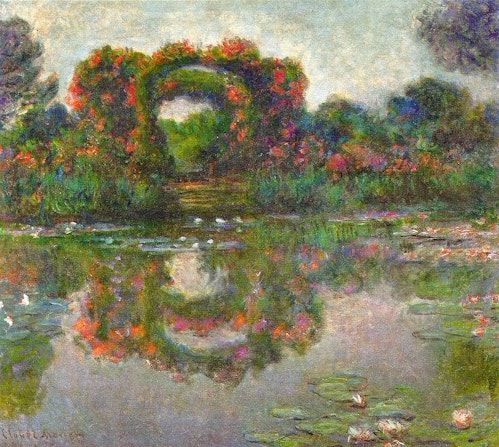
Arch of Flowers, Giverny (w.1779), 1913
He resumed work in 1913, but this time with a rose arch by the pond as his main motif.
The culmination of his life, a large decorative painting
The water lilies painted after 1915 are larger in size than those painted before that time.
Although Monet was already in his 70s, between 1914 and 1919, he produced 67 "Waterlilies," each nearly two meters in length, and including the three "Iris" paintings from the same period, he produced a total of 70 large paintings.

Waterlilies (w.1788), 1914-17
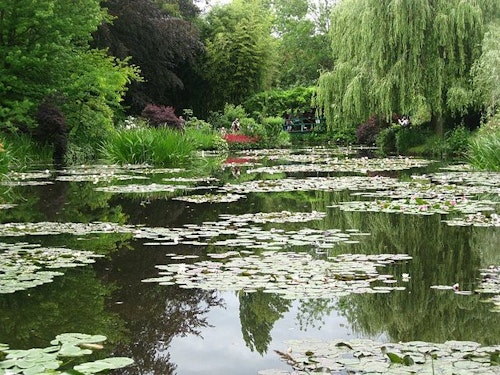
Photo of the garden at Monet's residence in Giverny
Planned as a "grand decorative painting," this series of large-scale water lilies eventually culminated in the large paintings in the collection of the Musée de l'Orangerie.
Viewed from a single fixed vantage point and ordered by perspective, the landscape is unlike anything in the Orangerie's wall paintings.
Viewing this work involves the physical experience of walking through the exhibition room and shifting perspectives.
This idea of the viewer being surrounded by the painting and entering into it has been pointed out as an influence of Japanese sliding door paintings.
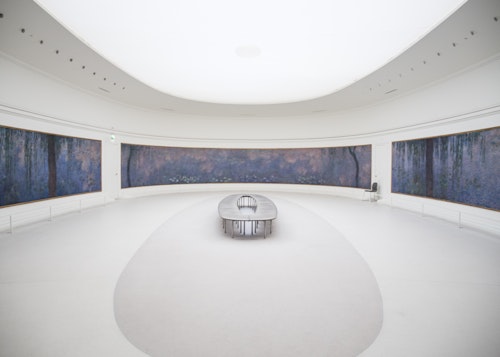
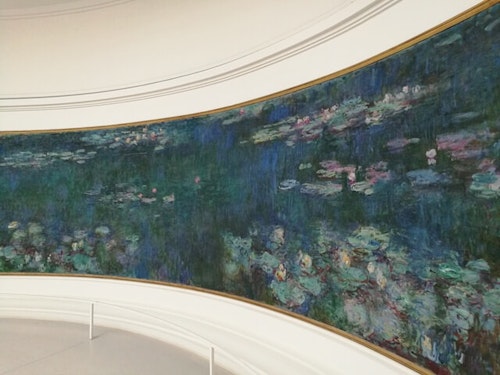
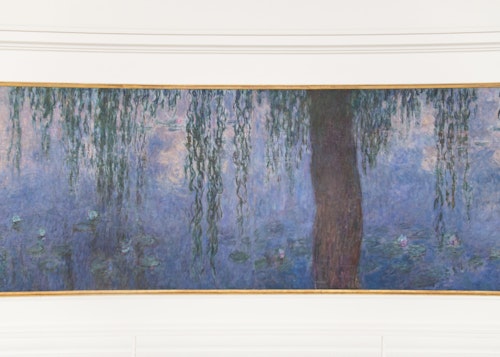
A view of the Musee de l'Orangerie
Brief description of Monet's life
Childhood ~.
Claude Monet, a French painter representing the Impressionists of the 19th century, was born on November 14, 1840 in Paris, France, the second son of a businessman father and a singer mother.
As a student, Monet was well known in the community for his charcoal drawings of portraits and caricatures with exaggerated features, which he sold.
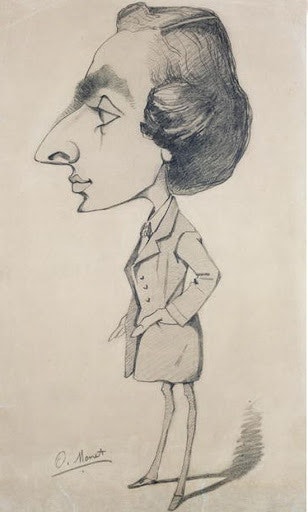
Path as a Painter
Monet wanted to move to Paris to study painting, and although his father was initially opposed, he gave permission for Monet to move there with the money he earned himself from selling caricatures and portraits. Thus, in 1859, Monet moved to Paris.
He did not like the academic art classes at the art school he entered in 1862, but went to the ateliers where he met painters like Renoir, Sisley, Pissarro, and Basile.
In 1865, Monet exhibited at the Salon de Paris, the only exhibition open to the public and a gateway to success for artists, and was selected for "The Seine Estuary at Honfleur" and "Cape Aves at Low Tide.
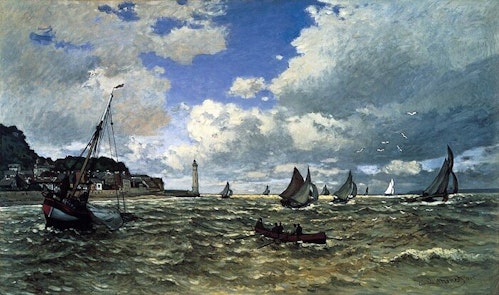
Monet lived in Argenteuil, a town northwest of Paris, from 1871 to 1878, and repeatedly painted the suburban landscape.
This beautiful winter scene is one of his paintings.
Monet painted snowy landscapes soon after he adopted the method of painting outdoors.
He actively pursued this subject matter, which was of little interest to his fellow painters, by pursuing the delicate effects of light playing on the white snow.
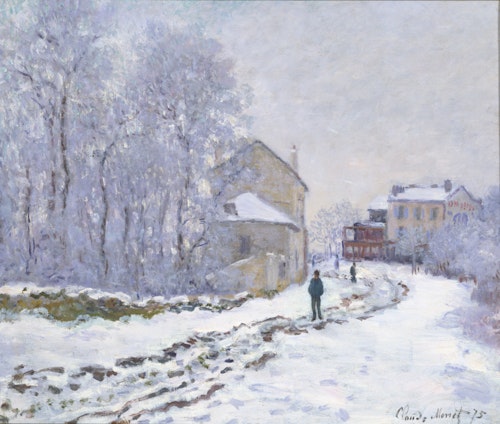
Argenteuil in the Snow, 1875
During his Argenteuil period, he repeatedly used his wife Camille and son Jean as models, depicting them in the landscape.
These works, which capture on canvas the beauty of a single moment, characteristic of Impressionism, also seem to evoke the fragility of Camille's early death in 1879.
Among his most famous works is "Walking, Woman with a Parasol," which is in the collection of the National Gallery of Art in Washington, D.C.
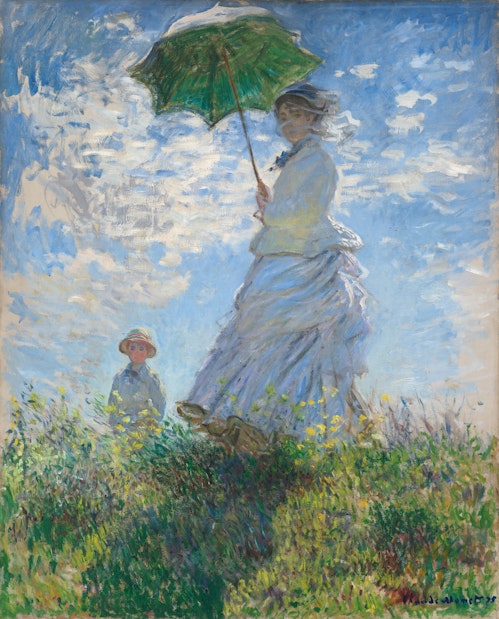
Walking, Woman with a Parasol, 1875
The Birth of Impressionism
Monet joined Renoir, Sisley, and other artists who had been rejected by the Salon de Paris, which, like Monet, had adopted a new style of painting that used bright, vivid colors to depict realistic landscapes, a style that was considered new at the time.
The first exhibition of the association was held in 1874, and at the legendary exhibition now known as the "First Impressionist Exhibition," Monet exhibited a work entitled "Impression, Sunrise.
The critics of the time criticized the work. The work was called "Impressionist" to ridicule the unfinished look of the brushwork, but Monet and his colleagues would later be recognized for their innovation, a rare brilliance in the history of art.

Impression, Sunrise, 1874
Artwork in a style similar to "Water Lilies
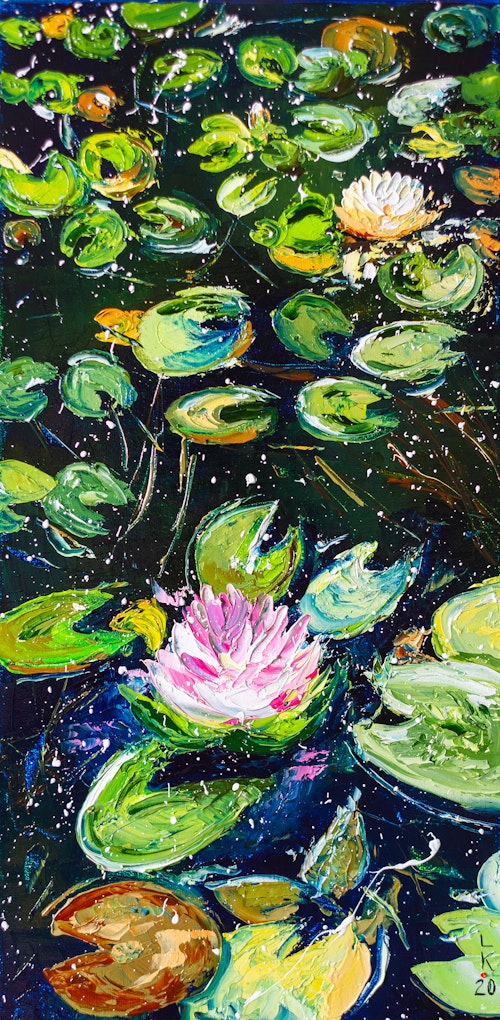
Water lily pond by by Liubov Kuptsova
W 20.00cm x H 40.00cm / 38,300Yen
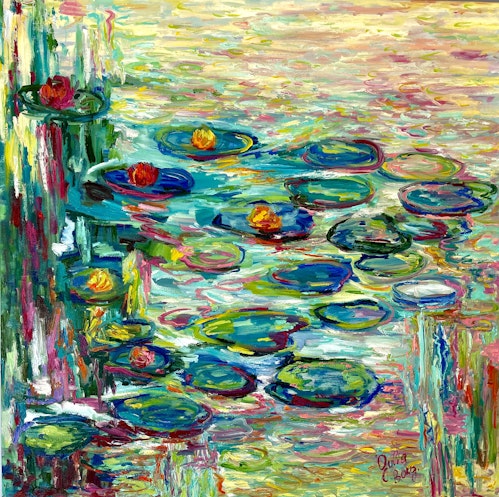
SPRING TIME by Julia Borg
W 90.00cm x H 90.00cm / 314,600Yen
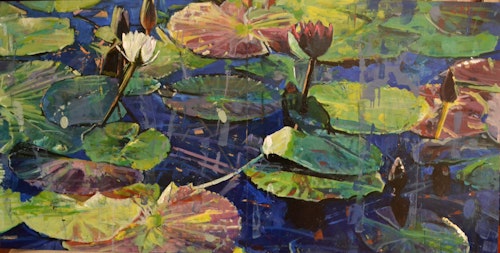
Waterlilies ( Diptych ) by Marco Ortolan
W 84.00cm x H 42.00cm / ¥237,500
Also Read
10 Masterpieces from Around the World
What exactly is Impressionism? History, famous painters and their works explained
10 Famous World Paintings|Learn more about modern art
Everything is beautiful! Summary of 10 museums overseas
Famous Western paintings can be seen in Japan! Museum Guide
TRiCERA ART members enjoy a wide range of privileges and preferences.
- Discounts such as members-only secret sales and coupons
- Create your own collection by registering your favorite artists
- Receive updates on popular artists, exhibitions, and events
- Receive a weekly newsletter with selected art
- Personal Assessment to find out what kind of art you like.
Please register as a member for free and receive the latest information.
Free Member Registration